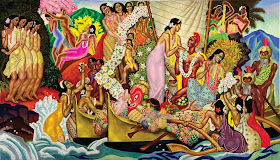Which leads me to the recent (3 July 2014 - 11 January 2015) exhibition at the Honolulu Museum of Art titled "Art Deco Hawaii" that I was able to visit a few days before it closed. There were some pieces of sculpture and some print items, but much of what was on display was paintings -- some were illustration art, others were fine arts images.
To me, Art Deco (a term retrospectively coined by Bevis Hillier in the late 1960s) is primarily an ornamentation style in architecture and graphic arts, secondarily a sculpture genre, and sometimes a variety of mannered illustration. As mentioned, not much in the way of paintings, though that's what the exhibit featured.
So-called Art Deco paintings fall into the category of simplified representation that was common between the two world wars. That is, aspects of pre-Great War modernism were incorporated in an effort to come to terms with modernism without going whole-hog. I deal with this in my e-book "Art Adrift" mentioned on this blog's sidebar. And that was pretty much what I saw: typical 1920s and 1930s paintings with little true Art Deco spirit. Nevertheless, I enjoyed my visit. Below are some images from the Internet along with some photos (a few are cropped slightly) that I took.
Girl with ukulele - Edward Eggleston - ca. 1925-30
Eggleston was an illustrator who seemed to specialize in pretty girls. I mention one of his travel posters here.
Lei Makers - Cornelia Macintyre Foley - 1934
Information on Foley (1909-2010) is here. Her style is that often seen in the 1930s, reminding me of the work of Mexican muralists active in those days.
Lithograph by Robert Riggs
Riggs was a leading illustrator in his time. David Apatoff wrote about him here. I didn't know that he dabbled in fine arts, so was surprised to spy this lithograph.
Discovery - Arman Manookian - 1928
Manookian (1904-1931) was born in Turkey, received his art education in the USA, served in the Marine Corps in the 1920s, practiced commercial and fine arts in Hawaii and then killed himself. More biographical information is here. According to the link, he didn't make many paintings over his brief career, and they are seldom shown publicly. So I was fortunate that several were on display. I consider the one above to be amongst his better ones.
Aloha ... the Universal Word - Eugene Savage - 1940
This was one of a set of murals that Savage (1883-1978) was commissioned to paint by the Matson Navigation Company, whose liners carried tourists and others between San Francisco and Honolulu for many decades. The murals were intended to be placed on the liners, but World War 2 intervened and the artwork wound up being reproduced on ships menus and such. Matson still owns the original murals, but large reproductions can be found in places such as Honolulu's Royal Hawaiian Hotel (once owned by Matson). I was pleased to be able to finally view the original artwork.
"Aloha" - detail
Pomp and Circumstance - Eugene Savage - 1940
Savage's Matson murals are crammed with detail, but that's the norm for mural paintings. His Hawaiians don't look very Hawaiian to me, but that really doesn't matter because Savage was trying to create evocations rather than documentation. An oddity in some of the murals is one figure staring out at viewers, as if caught by a camera. (Note the fellow towards the left side.) The paintings featured here include groups of females holding identical poses, which is a decorative characteristic of Art Deco.
"Pomp" - detail
Click to enlarge the two detail photos for a closer look at Savage's brushwork.








Hi Donald,
ReplyDeleteI just got your book, “Art Adrift” and am working through it. My purpose is to know more about the art movements of the early 20th century, and understand painting’s connection to Art Deco and the movement’s spirit. I am wondering if you have time to look at a project that your book touches on. There is a group of about 70 of Edward M. Eggleston’s images compiled on Wikimedia Commons, from 1914-1939. I’m wondering if you can point out any that fit trends in your book. Also, I’m trying to understand if Eggleston fits into any artistic movement, even though nearly all his surviving work was commercial. < https://commons.wikimedia.org/wiki/Edward_Mason_Eggleston>
Thank you,
Jack
I can be reached through Wikipedia, https://en.wikipedia.org/wiki/User:Jacqke
ReplyDelete